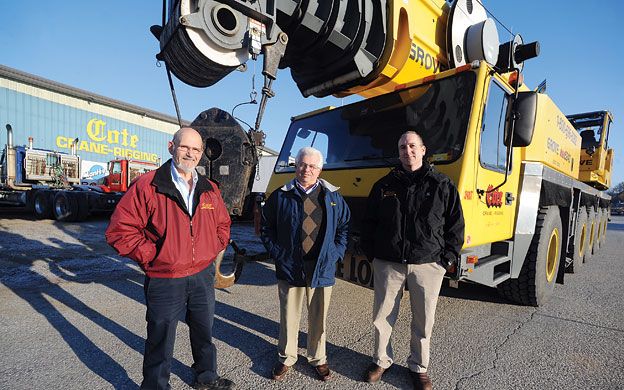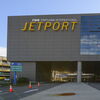‘Zero injuries’ is the norm at The Cote Corp.
 photo/Amber Waterman
Dan A. Cote Sr., left, CEO and treasurer of The Cote Corp., a crane and rigging company based in Auburn, is joined by the company's controller Daniel Gagne and his son, Daniel P. Cote Jr., who serves as vice president of operations and sales at the family-owned company. Founded in 1966 by Armand and Carmen Cote, the company makes safety a top priority ... and finds bottom line benefits as a result.
photo/Amber Waterman
Dan A. Cote Sr., left, CEO and treasurer of The Cote Corp., a crane and rigging company based in Auburn, is joined by the company's controller Daniel Gagne and his son, Daniel P. Cote Jr., who serves as vice president of operations and sales at the family-owned company. Founded in 1966 by Armand and Carmen Cote, the company makes safety a top priority ... and finds bottom line benefits as a result.
In the crane and rigging work The Cote Corp. performs — whether it's lifting a 20-ton vault into a new bank building, installing a $3 million MRI machine at a hospital or lowering a 9-foot marble statue of President George H.W. Bush through a rooftop opening into the main lobby of the University of New England — any accident very quickly can become costly or fatal.
“It's the nature of what we do,” says Daniel P. Cote Jr., vice president of operations and sales at the Auburn company co-founded in 1966 by his grandparents Armand and Carmen Cote. “People have dangerous, highly risky tasks they need someone to do for them. That's where we come in.”
His father, Dan A. Cote Sr., the company's CEO and treasurer, says a commitment to safety is built into the company's mission statement. Every worker is expected to embrace it, from senior management to the newest employees. Its importance is underscored by the zero-injuries awards proudly displayed at the company's headquarters. In an industry where weight is measured in tons not pounds, completing every job without an accident is the best way of achieving that zero-injuries goal.
“We believe all injuries and accidents are preventable,” he says. “Our people know from all the training we give them, that in today's world 'safety' has got to be every employee's top priority.”
That focus recently earned The Cote Corp. two important accolades: The prestigious PWD Maine Safety Award from the U.S. Navy in recognition of 20 years of zero-accident crane and rigging work — involving more than 2,000 crane lifts — at the Portsmouth Naval Shipyard; and designation as a finalist for the Leon Gorman Award from the Institute for Family-Owned Business, for “safely handling the biggest of the big is what The Cote Corp. is all about.”
A core value
Dan A. Cote Sr. says the focus on safety dates back to the company's founding.
His father paid his dues in the construction industry, doing bridge and utility contracting work for Callahan Bros. and heavy construction work for the Cianchette Bros. (the precursor to Cianbro) in Pittsfield. With his wife's encouragement and support, Armand decided to start his own crane and rigging company in large part because they hoped it would spare him the long stints away from home at job sites across the state.
The company's initial roster of employees consisted of Armand, his wife and their three sons, Dan, Paul and Ron.
“I grew up with the company,” Dan says, recalling how his father, after making sure his sons had completed their homework, would ask them what equipment would be needed at the next day's job site: Backhoe? Front shovel? Crane? “We'd go out, find which one was rolling the next day and service the machine. We were brought up, literally, in the business.
“Safety was always the No. 1 priority, we learned that at a young age. My Dad, being the sole source of our family business, if he were to get hurt, where's the company? So safety had to be a major component of the business. My Dad made sure each of us understood that: He wanted to make sure his boys wouldn't get hurt on the job either.”
Training is key
Fifty years ago, Dan says, “operating a crane was by feel” — meaning, a crane operator developed, job by job, a fine-tuned sensibility of what his crane could or could not do in relation to the length of its boom, the weight of whatever was being hoisted and the variables of ground conditions and space constraints of the particular job site.
The conventional cranes used by his father in the early days had booms of fixed length — 60, 200, 300 feet — and the magnitude of the load that could be lifted safely would be carefully calculated to ensure it would stay well below the tipping point.
The introduction of hydraulic cranes at The Cote Corp. in 1987, Dan says, offered greater flexibility, since the boom could be extended or lowered as needed. It didn't necessarily allow the company to take on heavier loads, he says, but it did make it easier to travel and set up at the job site.
“There's a market for a crane that can move quickly from one place to another,” says his son, Daniel Jr. “[Our customers] want a company doing that in Maine.”
Today's modern cranes are equipped with computerized stability systems that let the operator know when he might be approaching the tipping point or is trying to pick up a load that's too heavy. But even with that safety feature, both Dan and his son say Cote's crane operators are encouraged to hone their ability to assess risk beyond what the stability system is designed to detect.
Judgment and feeling, in other words, remain essential skills for getting the job done safely.
Training is the first step:
- Cote Corp. provides a safety orientation for all new employees and ongoing safety training for all veteran employees. All field employees complete a 10-hour Occupational Safety and Health Administration safety course designed to help them prevent accidents. They also participate in a Department of Transportation-approved drug and alcohol-testing program.
- Crane operators receive additional training to be certified by the National Commission for the Certification of Crane Operators. All cranes are certified by a third-party inspector.
- Cote's other workers undergo similar training, including the riggers who hook, unhook and guide the heavy loads hoisted by a crane; millwrights who handle the heavy machinery; truckers who choose trailers to transport loads ranging from heavy bulldozers to large boiler sections; and packers who package machinery, furniture and other large items for shipping.
Those additional trades help diversify Cote Corp.'s customer base and have enabled it to weather the decline of Maine's manufacturing industries, most notably paper companies. In Maine, its customers extend from Madawaska to Kittery. It also handles jobs in Vermont, New Hampshire and Massachusetts.
“I don't think there is enough of any one industry in Maine to make a living off of,” says Daniel Jr., who joined the family business in 2001 with an engineering degree from Clarkson University and five years of work experience at tech companies, including a stint as a safety director. “So diversification is important for us. Every customer's reasons for hiring us are different, but the most important reason is that they need to get it done correctly. Their livelihood, and ours, depends on it being put in there safely.”
The focus on safety is built into each job. Before heading out to the job site, the team does a “lift plan” based on the anticipated weight of whatever needs to be lifted. The ground at the job site is evaluated to make sure it will safely support the crane and its load. Then the project is turned over to a foreman and project manager, who assess what the job will require for machinery, methods and workers.
“Understanding the task allows us to make a team that's the right team for that particular job,” Daniel Jr. says.
The final authority, however, doesn't rest with the plan: The foreman and crane operator are charged with that responsibility at the job site. If they deem the wind too strong, the ground too soft or see something that's amiss, they're empowered to shut the job down until it can be done safely.
Safety pays
Daniel Gagne, the company's controller for 20 years, says the emphasis on safety is never seen by the owners as a drag on the company's performance.
In fact, he says, there's been a bottom-line payoff on two fronts: It registers with every employee that the company cares about their well-being, which encourages loyalty and reduces turnover; it also lowers the company's workers' compensation and liability insurance costs.
The average Cote employee has worked for the company close to 15 years, he says. That gives the company a wide pool of experienced workers with multiple skills that can be tapped in a variety of ways. That, in turn, enhances the company's ability to diversify its services.
“We really focus on developing our people and providing them with a place to work that's very stable,” says Daniel Jr. “That allows us to capitalize on their experience … In the construction industry, there tends to be an extreme amount of turnover. We've been able to 'grow' a team of very experienced people, and they're able to 'grow' and teach the team beneath them. I don't think our company could exist without skilled people.”
Gagne says The Cote Corp.'s long track record as a zero-injury company enables it to pay lower workers' comp insurance premiums. The key number is what is known as the “mod rate” – the experience modification rating determined by the Workers Compensation Insurance Rating Bureau. The rate is based on the company's premiums, frequency and types of claims, and the amount paid on any claims over a three-year period, with the greatest weight being given to the most current year.
Values less than 1.00 reflect a better-than-average claims history compared to other companies in the same industry, while values over 1.00 reflect a worse-than-average history. The Cote Corp.'s mod rate is .71.
“In our industry, that's unheard of,” says Daniel Jr. “That's why zero injuries is something we celebrate every year. It's a goal we take very seriously.”
Having a mod rate that's lower than the industry standard also helps the company line up work, since it's used by prospective clients in the prequalification process to evaluate contractor bids. All other things being equal, the contractor with the lower rate is likely to get the nod — in part, due to the client's own liability concerns and desire to limit risks on jobs involving incredibly heavy and expensive objects that must be moved and placed with precision.
“There are many companies out there who won't use someone with a high mod rate,” says Gagne. “You won't be able to work for certain contractors … there are facility owners who aren't going to allow you to work at their property.”
Research conducted for The Business Roundtable, a national association of CEOs of large U.S. companies, supports the point that active owner participation in safety initiatives benefits a company's bottom-line performance. Citing a three-to-five-fold reduction in workplace accidents for construction companies with strong owner involvement in safety initiatives, the researchers found the reduction in the number and severity of accidents “lowers accident costs by as much as 8% of direct construction labor payroll.”
Those numbers, the researchers conclude, should provide “a compelling economic incentive for owners to demand construction safety.”
Dan Sr., who earned a degree in finance from Husson College, followed in his father's footsteps by becoming a skilled crane operator, rigger and millwright. He notes with pride that his father, now 83, remains active in the company and is known to hop into his pickup truck and drive to any job site he thinks might have something “interesting” going on.
Patriarch Armand Cote defines a good crane operator as “a man who can go out there and please the people paying for his work and come back with a machine that's in one piece.” Implicit in that definition is the operator arriving home in one piece as well.
He credits his own apprenticeship under Fred Callahan, during the 14 years he worked for the Callahan Bros. doing a lot of crane work on bridges, as setting the foundation for the strong safety focus at The Cote Corp.
“In those days, we operated by the seat of our pants,” he says. “But if you got into a machine and you didn't feel it was safe you didn't do the work … When I first started the company I was 36 years old. I couldn't afford an accident. An accident would put me out of business.”










Comments